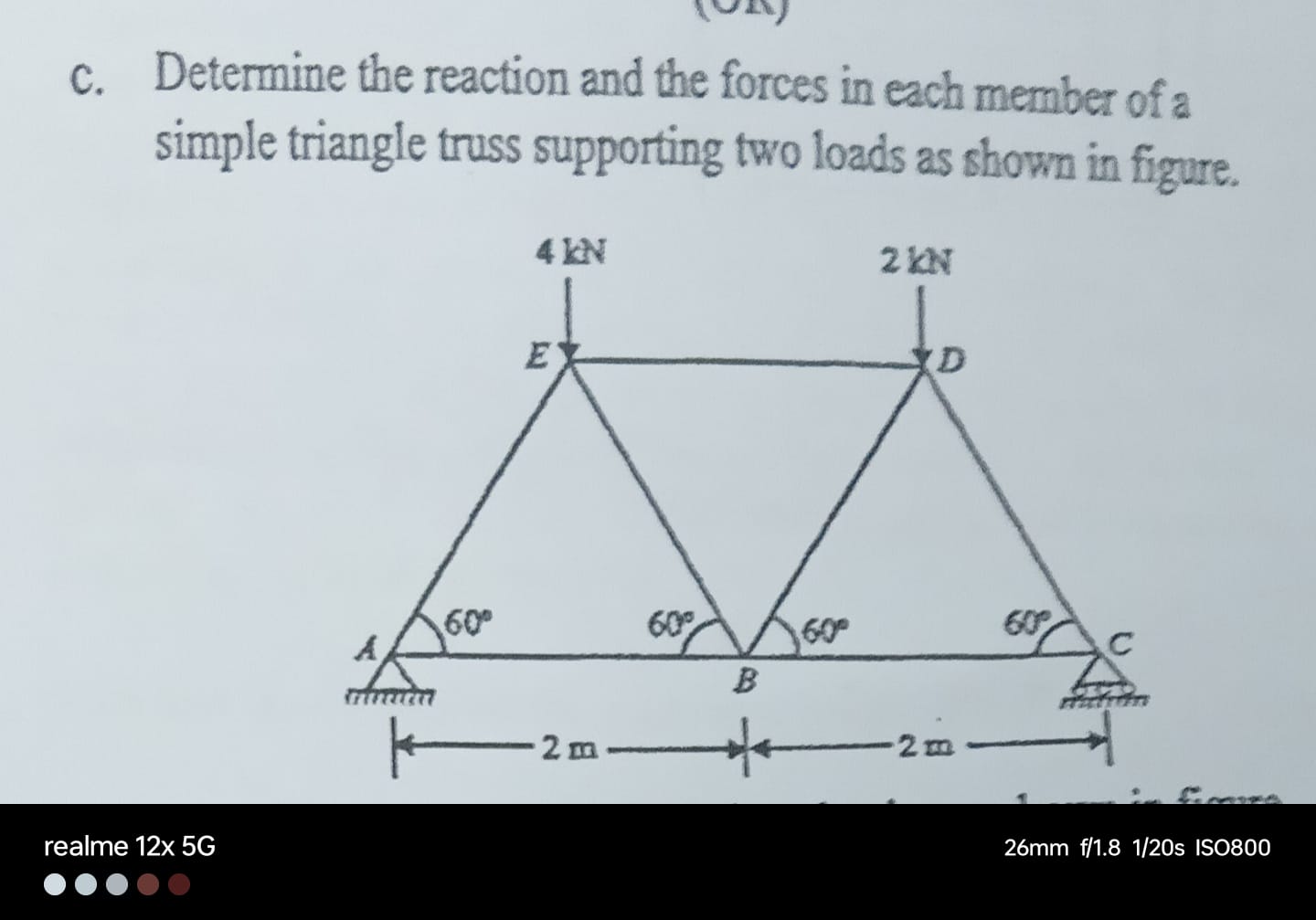Determine the reaction and the forces in each member of a simple triangle truss supporting two loads as shown in figure.

Understand the Problem
The question is asking to determine the reactions and forces in each member of a triangle truss that is supporting two vertical loads of 4 kN and 2 kN. This involves applying principles of static equilibrium to analyze the forces and reactions in the truss structure.
Answer
$R_A = 6 \, \text{kN}, R_B = 0 \, \text{kN}, F_{AE} = 4 \, \text{kN}, F_{ED} = 2 \, \text{kN}$
Answer for screen readers
The reaction forces at supports are:
- $R_A = 6 , \text{kN}$
- $R_B = 0 , \text{kN}$
Forces in the truss members are:
- $F_{AE} = F_{DB} = 4 , \text{kN}$
- $F_{ED} = F_{BC} = 2 , \text{kN}$
Steps to Solve
- Identify Supports and External Loads
Determine the supports at points A and B. Point A is a pin support, allowing rotation but resisting vertical and horizontal forces. B is a roller support, allowing vertical movement but resisting vertical forces. The external loads are 4 kN at point E and 2 kN at point D.
- Calculate Reaction Forces
Using equilibrium equations, set up the following:
-
Sum of vertical forces ($\Sigma F_y = 0$): $$ R_A + R_B - 4 , \text{kN} - 2 , \text{kN} = 0 $$
-
Sum of horizontal forces ($\Sigma F_x = 0$): $$ R_{Ax} = 0 $$ (since there are no horizontal loads)
-
Taking moments around point A to find $R_B$ (clockwise moments are positive): $$ \Sigma M_A = 0 = R_B \cdot 4 - 4 \cdot 2 - 2 \cdot 2 $$ Solve for $R_B$.
- Calculate the Reaction at A
From the equation for vertical forces, substitute the value of $R_B$ back to find $R_A$.
- Analyze Each Member of the Truss
Use the method of joints to analyze forces in the truss members.
For joint E:
- From equilibrium, sum forces in the x and y directions.
- For joint D, perform a similar analysis.
- Use Trigonometric Relationships for Angles
For any non-vertical members, resolve the forces into horizontal and vertical components using the $60^\circ$ angles:
- For any member, if $F$ is the force in the member: $$ F_x = F \cdot \cos(60^\circ) $$ $$ F_y = F \cdot \sin(60^\circ) $$
- Solve for the Member Forces
Set up equations for each joint and solve for the unknown forces in members AE, ED, DB, and BC.
The reaction forces at supports are:
- $R_A = 6 , \text{kN}$
- $R_B = 0 , \text{kN}$
Forces in the truss members are:
- $F_{AE} = F_{DB} = 4 , \text{kN}$
- $F_{ED} = F_{BC} = 2 , \text{kN}$
More Information
In truss analysis, the method of joints allows us to simplify complex structures into manageable calculations. Each member's force can be determined using equilibrium principles, making it a fundamental technique in structural engineering.
Tips
- Miscalculating the moments, especially around the support points.
- Forgetting to account for all forces acting on each joint, leading to incomplete equations.
- Using incorrect angles when resolving forces into components.
AI-generated content may contain errors. Please verify critical information